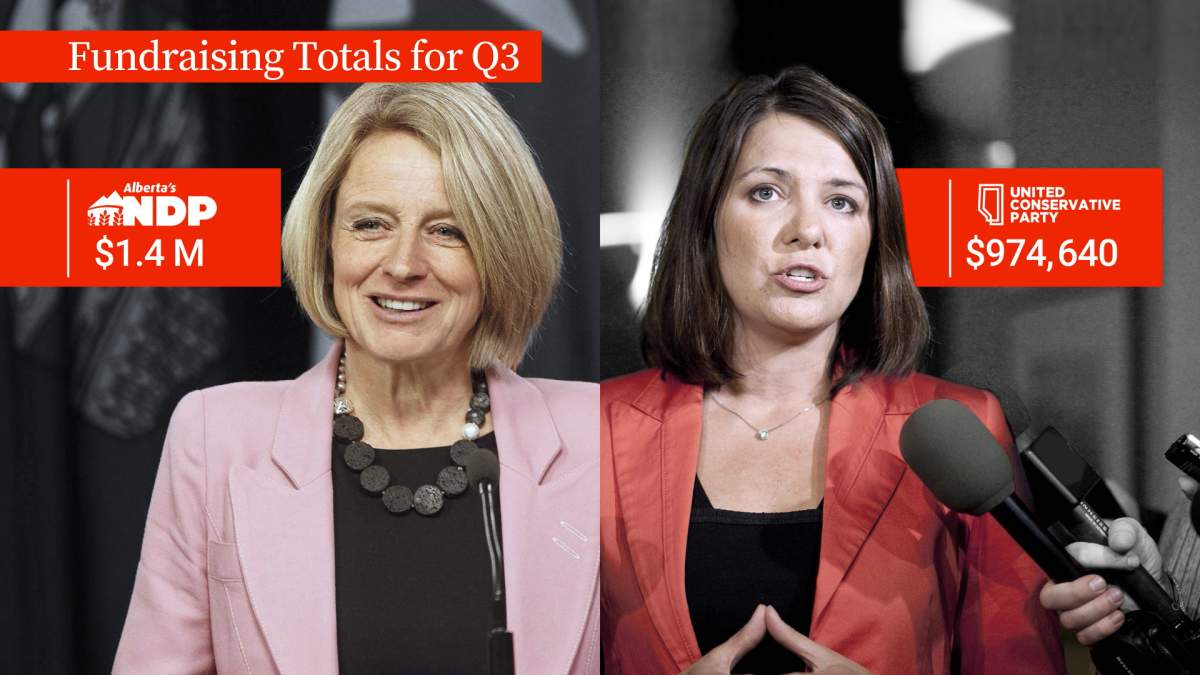The most recent fundraising totals for political parties in Alberta help paint a picture of the province’s political landscape.

When it comes to raising money, Alberta’s two main parties have out-earned the other parties by hundreds of thousands of dollars, according to Elections Alberta’s Q3 report.
The report shows the Alberta NDP raised $1,435,563.94 in Q3 and the UCP fundraised $974,640.57.

Political scientist Feodor Snagovsky said these Q3 fundraising numbers show a sign of a healthy democracy, with a two-party system clearly established.
He referenced the Progressive Conservatives, who governed for more than 40 years with little alternation of power until the NDP’s “orange crush” in 2015.
In a startling turn, Rachel Notley’s NDP won a majority government in Alberta on May 4, 2015, ending the 44-year reign of the Progressive Conservatives.
“Now that we’ve moved to a two-party system, I think that’s a really good thing,” he explained.
“There are challenges to the governing party not just from within, but actually two parties that could conceivably form government.”
Prolife Alberta earned third place for fundraising in Q3 with $51,126.94.
The group, which has never held a seat in the Alberta legislature, raised more money than the Alberta Party and Liberal Party combined.

Get weekly money news
Richard Durr, executive director for Prolife Alberta, said he believes his party’s fundraising totals can be attributed to some Albertans directing their money towards a specific set of values.
“There’s a two-party system, as it were, and both parties are neglecting to address right to life issues and the beneficiary of that is our association,” Durr said.

Durr said it would be a “wait and see approach” if the party put forth any candidates for the next Alberta election.
Snagovsky said a party that has earned fundraising dollars without a clear path for nominating candidates can mean a singular idea has resonated with a group of Albertans.
“There are different kinds of political parties. Some try to form government and some try to pursue a particular ideology or one policy platform,” he explained.
Whereas people who might otherwise donate to the Liberal Party or Alberta Party might be more interested in supporting a party that could actually form government,” he said.
“The people who are supporting abortion groups have no hope — they aren’t sitting around thinking that party will eventually form government.”
Alberta Party leader Barry Morishita said he is hoping to help his party capture some more attention — and fundraising dollars — in the next election.
Morishita said he expects growth to take a bit of time.
“We haven’t had a breakthrough… it’s going to take a lot of effort to push us over the hump.”
Snagovsky said he’s not sure that Alberta will see a three- or four-party race, partially because of the first-past-the-post system.

“The party with the most votes wins, so it doesn’t leave a whole lot of room for third parties to emerge because they end up splitting the vote,” he explained.
“That’s what happened with the PCs and the Wildrose Party and one of the reasons why they ultimately formed the UCP.”
“They compete for attention from voters for sure,” he said.
“The reality is a lot of the times political parties aren’t changing too many minds. They are mostly competing on who can get the voters to consider their issues the most important.”
Elections Alberta said Q4 fundraising will be released on Jan. 31, 2022.











Comments